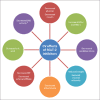Cardiovascular Effects of Sodium Glucose Co-transporter-2 Inhibitors in Patients with Type 2 Diabetes Mellitus
- PMID: 31016170
- PMCID: PMC6446691
- DOI: 10.4103/ijem.IJEM_161_17
Cardiovascular Effects of Sodium Glucose Co-transporter-2 Inhibitors in Patients with Type 2 Diabetes Mellitus
Abstract
Type 2 diabetes mellitus (T2DM), the leading type of diabetes, has a typical association with coronary heart disease. In India, patients with diabetes are at an increased risk of developing coronary disease as compared to people without diabetes and this suggests the requirement of intensive treatment of cardiovascular (CV) risk factors. Consequently, there is a need for an intervention that could target CV risk factors in multiple paths beyond hyperglycemic control alone. Although metformin is the mainstay of treatment in most of the patients with T2DM, a second line of treatment with anti-hyperglycemic agent is warranted in patients with T2DM in the management of CV risk factors beyond glycemic control. Sodium glucose co-transporter-2 (SGLT-2) inhibitors, the oral hypoglycemic drug, that act independent of insulin secretion are associated with a reduced risk of hypoglycemia which is associated with the increased risk of CV events. Moreover, it has been observed that the use of SGLT-2 inhibitors in patients with T2DM is associated with reductions in blood pressure and body weight beyond improved glycemic control. In this article, the clinical efficacy, safety, and tolerability of SGLT-2 inhibitors on glycemic, nonglycemic parameters, and CV outcome including data from the EMPA-REG OUTCOME study are discussed. The EMPA-REG OUTCOME study is the first CV outcome study that demonstrated the association of a glucose lowering agent with the reduced CV mortality and all-cause mortality, and reduced hospitalization for heart failure in patients with T2DM at high risk of CV events. Although the mode of action associated with the CV benefits remains unknown, data from ongoing trials including DECLARE-TIMI (Dapagliflozin Effect on CV Events) and CANVAS (Canagliflozin CV Assessment Study) trials potentially can validate the class-effect for SGLT-2 inhibitors regarding the CV outcomes.
Keywords: Cardiovascular benefits; sodium glucose co-transporter-2 inhibitors; type 2 diabetes mellitus.
Conflict of interest statement
There are no conflicts of interest.
Figures





Similar articles
-
[Outcome studies on SGLT-2 inhibitors].Internist (Berl). 2019 Sep;60(9):903-911. doi: 10.1007/s00108-019-0656-x. Internist (Berl). 2019. PMID: 31375850 Review. German.
-
EMPA-REG and Other Cardiovascular Outcome Trials of Glucose-lowering Agents: Implications for Future Treatment Strategies in Type 2 Diabetes Mellitus.Clin Ther. 2016 Jun;38(6):1288-1298. doi: 10.1016/j.clinthera.2016.04.037. Epub 2016 May 19. Clin Ther. 2016. PMID: 27210264
-
Cardiovascular Protection with Anti-hyperglycemic Agents.Am J Cardiovasc Drugs. 2019 Jun;19(3):249-257. doi: 10.1007/s40256-019-00325-9. Am J Cardiovasc Drugs. 2019. PMID: 30767126 Review.
-
Do the SGLT-2 Inhibitors Offer More than Hypoglycemic Activity?Cardiovasc Drugs Ther. 2018 Apr;32(2):213-222. doi: 10.1007/s10557-018-6786-x. Cardiovasc Drugs Ther. 2018. PMID: 29679303 Review.
-
Update on SGLT2 Inhibitors-New Data Released at the American Diabetes Association.Crit Pathw Cardiol. 2017 Sep;16(3):93-95. doi: 10.1097/HPC.0000000000000125. Crit Pathw Cardiol. 2017. PMID: 28742644 Review.
Cited by
-
Sodium-glucose co-transporter 2 inhibitors and heart failure-the present and the future.Heart Fail Rev. 2021 Jul;26(4):953-960. doi: 10.1007/s10741-020-09925-z. Heart Fail Rev. 2021. PMID: 32020487 Review.
References
-
- World Health Organization. Diabetes. 2016. [Last accessed on 2016 Jul 19]. Available from: http://www.who.int/mediacentre/factsheets/fs312/en/
-
- Kannel WB, McGee DL. Diabetes and cardiovascular disease. The Framingham Study. JAMA. 1979;241:2035–8. - PubMed
-
- Haffner SM, Lehto S, Rönnemaa T, Pyörälä K, Laakso M. Mortality from coronary heart disease in subjects with type 2 diabetes and in nondiabetic subjects with and without prior myocardial infarction. N Engl J Med. 1998;339:229–34. - PubMed

